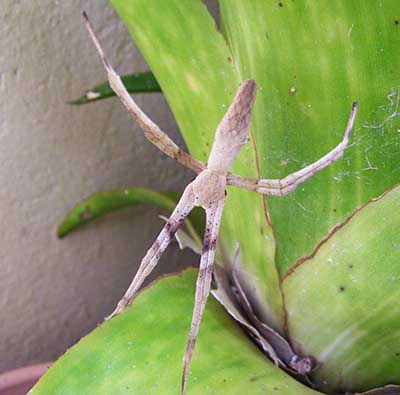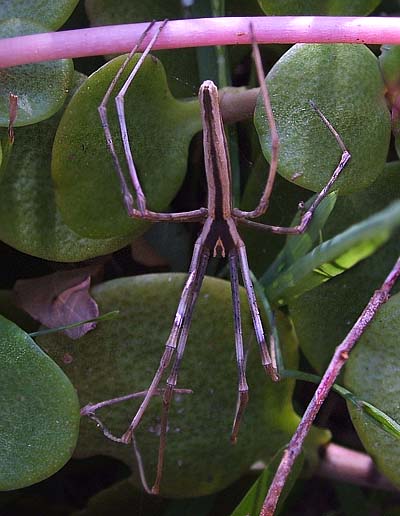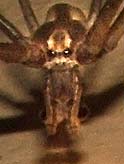Backyard Spiders. Budgewoi to Bateau Bay.

Home

This site was built with assistance from the following sites and people. We recommend them for further information and identification and thank their builders and owners for the excellent resources they have provided.
Dr. Ron Atkinson's. Find A Spider Guide. Robert Whyte and Dr. Greg Anderson's Arachne.org. The Chew Brothers' Brisbane Insects.
Ed Nieuwenhueys. Spiders of Australia. as well as Project Noah.
BN98181215
Quick guide to common spiders
ARANEIDAE Orb Weavers
CORINNIDAE Corinnids
DESIDAE Intertidal Spiders
DEINOPIDAE Net-casters
HERSILIIDAE Two-tailed Spiders
LAMPONIDAE White tails
LYCOSIDAE Wolf Spiders
OXYOPIDAE Lynx Spider
SPARASSIDAE Huntsman
TETRAGNATHIDAE
THERIDIIDAE Theridiids
THOMISIDAE Crab spiders
ZORIDAE. Wandering Ghosts

Ogre Faced Spider

These spiders hunt using an amazing net of about 2cm square. They relax and hold the net loosely until they see prey. They move into casting range and spread the net tightly between their legs before using the tension to flinging it over the prey. The net probably snaps back into shape as it stikes making the contact with the prey even more secure. The Web-casting Spider hunts at night. All of the pictures above the hunting scene are of day-time resting spots or resting by their hunting spot.
Web-casting Spider. Deinopis subrufa or ravida
Commonly called Net-casting and Ogre-faced spiders these are a large, slow moving spider normally found among complex foliage close to the ground. The male spider below has found a safe patch of open space among these succulents and will hang there until night fall when it will find a spot nearby to sit with it's web ready to pounce They are quite a desirable part of a well-made garden. They need patches of relatively undisturbed foliage close to the ground as well as regular watering. I have not found them in "dry" areas of the garden but they were common among the pot plants which were watered regularly

These spiders make a relatively large, round globe for their eggs and use leafy detritus to assist to disguise it from view. Below.
The spider at the top of the page is a female and the one in the middle is a male. These are the standard poses the spiders will rest in during the day and are very much a part of helping us to identify the species. The female at the top may vary in colour from pale grey to a red brown but the pose is almost always the same and with the body shape quite distinctive

